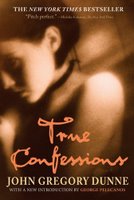 her most recent memoir, The Year of Magical Thinking. He was also the younger brother to Dominick Dunne, gossip maven to the stars, and the obvious model for a supporting character in the best mystery I’ve read this year.
her most recent memoir, The Year of Magical Thinking. He was also the younger brother to Dominick Dunne, gossip maven to the stars, and the obvious model for a supporting character in the best mystery I’ve read this year.But beyond familial connections, Dunne was also a writer of the first tier. Equally at home in fiction, non-fiction, and Hollywood, he published in 1997 one of the great modern classics of crime fiction, True Confessions. Taking more than a few cues from the infamous Black Dahlia murder of 1947, True Confessions explores the masks that obscure the faces of even close family, while dissecting the official Los Angeles power structure and the Catholic Church. Dunne and Didion collaborated on the screenplay for the Ulu Grosbard film, itself a noir treasure.
In between novels and film assignments, Dunne contributed frequently to The New York Review of Books, writing numerous reviews, essays, and political commentary. True, his career contained some dreck amongst the nuggets of gold, but he was never less than compelling.
I first encountered John Gregory Dunne in the mid-’80s, while I was still in college. I had taken full advantage of “student discount” magazine subscriptions, and it was during this time that Dunne began writing a column about writing for Esquire. To my knowledge, few of those pieces have been collected, although the best of the bunch, “Laying Pipe,” appears in Regards, his posthumous collection. In that essay, he describes how he wrote The Red White and Blue, plowing ahead despite lucrative interruptions from Hollywood. Among the charming idiosyncrasies divulged was Dunne’s habit of not beginning a book until he knew both the first and last lines.
As I said, those were marvelous essays, and well worth spending time in the microfilm room at your local public library to read. Meanwhile, the years have rolled, I’m older, he’s gone, but his work still makes me smile and shake my head in admiration.

















No comments:
Post a Comment